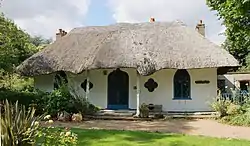Cottage orné
Cottage orné[1] (French for 'decorated cottage') dates back to a movement of "rustic" stylised cottages of the late 18th and early 19th centuries during the Romantic movement,[2] when some sought to discover a more natural way of living as opposed to the formality of the preceding Baroque and Neoclassical architectural styles. English Heritage define the term as "A rustic building of picturesque design."[3] They often feature well-shaped thatch roofs with ornate timberwork.

England
These buildings were generally built by the wealthy either as rustic retreats for themselves or as embellishments for their estates. They were not necessarily cottages in the usual sense of a small dwelling for the rural poor: examples range from the cluster of retirement cottages built by a Bristol banker for his retired staff at Blaise Hamlet to the expansive Royal Lodge, built by king George IV for his own use. Houghton Lodge, Hampshire is a fine example with beautiful gardens.
The cottage orné is the archetypal "chocolate box" cottage, but many chocolate box cottages are attractive cottages of conventional purpose, in no way associated with the Romantic era cottage orné.
United States
In the United States, the style was exemplified by the use of rustic motifs with a picturesque use of lattice/trellis, fancy scrollsaw work, and lightweight porch supports.
See also
Notes and references
- From the masculine French noun le cottage (Larousse French Dictionary) from the English word "cottage", from the ancient French word cote, "a cabin". Used in modern French to denote une petite maison de campagne rustique et elegante.
- Sturgis, Russell (1901). A Dictionary of Architecture and Building. Macmillan. p. 1/694.
- "Thesaurus". English Heritage. Archived from the original on 7 August 2012. Retrieved 29 May 2012.
Further reading
- Lyall, S. (1988), Dream Cottages: From Cottage Ornée to Stockbroker Tudor. 200 years of the Cult of the Vernacular. Hale, London.
External links
| Wikimedia Commons has media related to Cottage orné. |